Blog
"Sensus" - Making Exhibits Social and Sharable
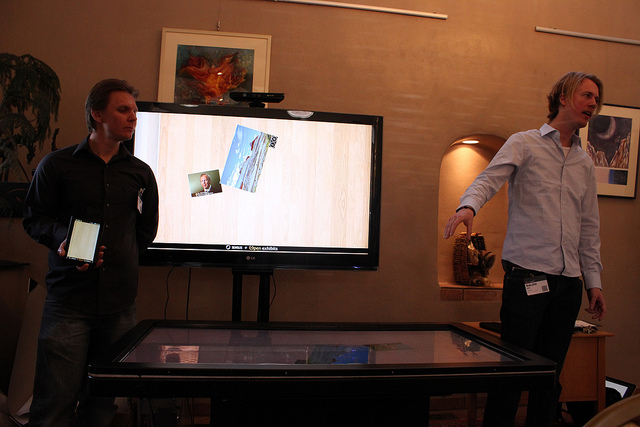
Ralph Das is the Chief Technical Officer of Amsterdam-based Sensus, an innovative company focused on the development and application of multi-touch technologies. He spoke at the 2011 Open Exhibits Summit about the limitations of local networks and Sensus' plan to overcome those limitations to enhance the museum exhibit experience.
Primary challenges include:
- Local networks are confusing
- Networks share files, not experiences, they're not social by nature
- There are many different network formats
- Devices exist in bubbles of proprietary technology which don't play well with other devices over a network
Mr. Das focused on the potential for sharing within the exhibit experience, and noted that "going social for exhibits is very hard." To overcome this challenge, Sensus has developed a "shared area," a "large display with high resolution" coupled with Wi-Fi networks and personal devices. Sensus designed what Das called a very simple application that allows different devices to communicate with each other without concern for the nature of their operating systems or the networks they share.

"As long as you have the application, it just works," said Mr. Das. This technology allows a visitor to interact with the multitouch table then take objects from the table with them on their personal device, such as a smartphone, tablet PC or other network display device. This gives the exhibit a freer and more interactive nuance by adding mobility.
The Sensus platform also allows for museums to network their collections and share resources and objects over the internet via Sensus' dedicated application.
Mr. Das said the technology is still in the development phase, adding, "We're ping-ponging -- back and forth -- to develop this application; that's why we're here [at the Open Exhibits Summit]."
According to Das, the ultimate goal is a clean solution. "We want to keep it very simple," Das said, adding, "Why not let the technology talk to everything -- all devices? That's what this does."
Social Opportunities Around a Multitouch Table
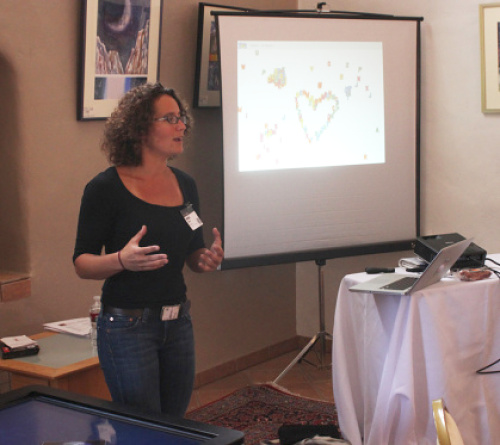 Nina Simon is founder of Museum 2.0, a consultancy that focuses on creating exhibits that promote social interaction. Nina strives to make exhibits and programs that encourage visitors to contribute to institutions and engage socially with each other.
Nina Simon is founder of Museum 2.0, a consultancy that focuses on creating exhibits that promote social interaction. Nina strives to make exhibits and programs that encourage visitors to contribute to institutions and engage socially with each other.
At the Open Exhibits Design Summit, she discussed the many barriers to engaging groups of strangers in museums, particularly in North America. Visitors typically interact within their own personal group(s). Therefore, you can’t assume that visitors will interact with strangers and it’s necessary to build opportunities for social interaction into the exhibit design.
How do you do this? Here are Nina's suggestions:
DON’T ASSUME INTERACTION
One of the ways to build in interaction is to incorporate signs that sanction or give permission for people to talk to strangers at an exhibit. In past exhibits, Nina used signs like “Go up to someone your height and ask them to do this activity with you” or “Ask someone of the same gender to do this exhibit with you.”
"It’s important to put the onus of responsibility on the museum to facilitate these connections." Nina sees the museum acting like a party host who introduces guests to each other."
Jumping in Museums is a great example of a project that facilitates strangers coming together to participate in a fun experience."
MAXIMIZE FLEXIBILITY, MINIMIZE DISRUPTION
In a museum exhibit, it is important to maximize flexibility and minimize disruption. People approach exhibits at different times and leave at their own pace. Exhibits cannot require that people start or end together and changes in engagement cannot stop or ruin the group’s experience.
So, how do we create shared activities that allow for personal flexibility, without disrupting the exhibit? For example: with multitouch tables, where users are manipulating objects in a shared environment, how do we minimize users' ability to steal objects from other users or “ruin” other users play?
Creating exhibits that have a balance of personal space and shared space is one answer. Or is it? In a game like Just Letters users manipulate alphabet-shaped refrigerator magnets. Part of the fun of this game is that people are stealing each other’s letters. Proving there are ways to create fun experiences that utilize disruption by design.
TO PROMOTE SOCIAL INTERACTION, MAKE IT CORE TO THE DESIGN

Nina also described an advice wall in a museum where visitors would post questions like “What do you do for a hangover?” Other visitors write answers on post-its and stick them onto the board, and the sense of a large conversation was created.
"The exhibit was inherently social, effective at connecting strangers, and allowed people to interact on their own schedules and at their own pace; a hallmark of multiuser design."
Jeff Heywood on the "Novelty" and "Honey Pot" effects of multitouch exhibits
 Jeff Heywood is the Director of Content at Vancouver Aquarium. Having worked as a director in television, he describes himself as a natural storyteller.
Jeff Heywood is the Director of Content at Vancouver Aquarium. Having worked as a director in television, he describes himself as a natural storyteller.
Mr. Heywood spoke at the Open Exhibits Summit about a direct study done at the Vancouver Aquarium. Visitors were recorded as they interacted with a multi-touch table exhibit called “Arctic Exploration.”
Mr. Heywood shared the results and the data that formed his goals for an effective table experience:
- The most fresh and current content
- Active connections to the subject matter
- Self-directed interaction with many levels of exploration
- Exhibit software must allow updates in-house
Jeff Heywood described two effects of incorporating the multi-touch table into the Arctic Explorations exhibit:
- - The Novelty Effect: Multi-touch tables are still relatively new technology for many people.
- - The Honey Pot Effect: Visitors enjoyed the tables's hands-on and interactive nature; they controlled the media.

From these initial effects, Mr. Heywood and his colleagues noted that table interaction is an individual experience — people didn't talk while using the tables. Mr. Heywood outlined goals for enhancing and broadening the experience:
- There should be a touch-and-see response
- The tables should be kid-proof (there was a spill within 10 minutes of opening the exhibit)
- There should be a place where visitors can unload what they are carrying in order to interact with the tables
- Video used must be high quality
Using what they learned, Mr. Heywood said, "A combination of both digital and traditional information presentation can therefore greatly enhance visitors' experience of exhibitions." Considering these goals, Mr. Heywood added:
"Don't worry if you don't have a perfect solution the first time out." Despite initial problems, kids of all ages still had a great time."
Tuning In to the Open Exhibits Design Summit
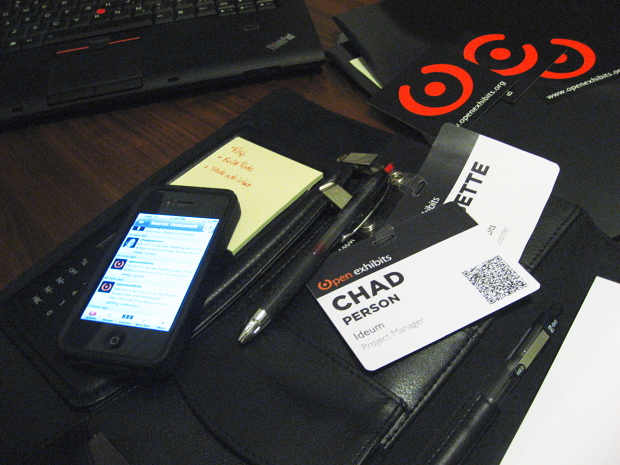
The Open Exhibits Design Summit begins tomorrow. Thirty museum professionals, programmers, and designers have come together to participate in two days of presentations and activities designed to help shape the Open Exhibits project as we move forward. We want to share what promises to be an insightful conversation with you.
During the summit we will be blogging, tweeting, and posting event images on flickr.
We'll be tweeting @openexhibits using the hash-tag #oesummit
You can view photos of the Summit on Flickr in the OEsummit Group.
For the latest blog posts, please subscribe to our RSS feed or visit the Research and Design page periodically.
An introduction to the Open Exhibits Design Summit
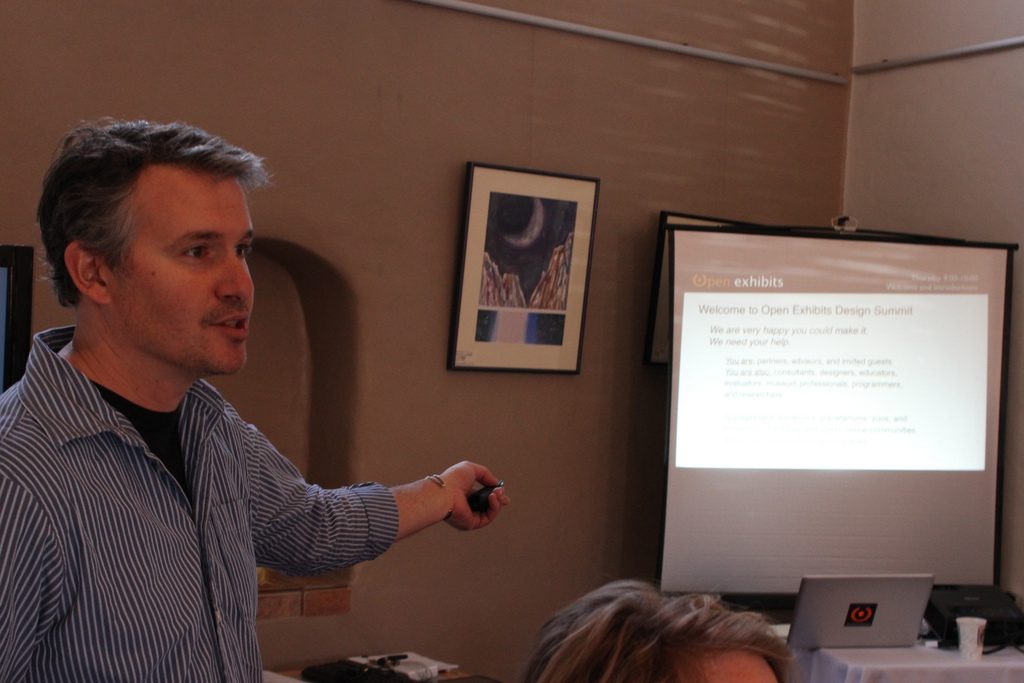
Jim Spadaccini introducing the Open Exhibits Design Summit in Corrales, NM, March 2011.
The Open Exhibits Design Summit has attracted over 30 experts from art museums, zoos, planetariums, ISE, aquariums, research, and technology development. The project partners, advisors, and invited guests have committed to two days of design exercises and discussions to shape the future of the Open Exhibits project and community. Jim Spadaccini, Principal Investigator, said the goal of attracting such a diverse group of experts is to effectively crowd-source the future of Open Exhibits and its strategies.
"I think we've done a great job for the last six months," Spadaccini said, "and now we're looking for all of your input to guide us into the future through feedback and assessments," he told the group.
 The design summit, as outlined by Mr. Spadaccini, includes strengthening the Open Exhibits community (currently over 700 members); determining how best to design the first Open Exhibits software templates and exhibits; and learning how to optimize the presentation of museum collections and educator applications on-site and for the web.
The design summit, as outlined by Mr. Spadaccini, includes strengthening the Open Exhibits community (currently over 700 members); determining how best to design the first Open Exhibits software templates and exhibits; and learning how to optimize the presentation of museum collections and educator applications on-site and for the web.
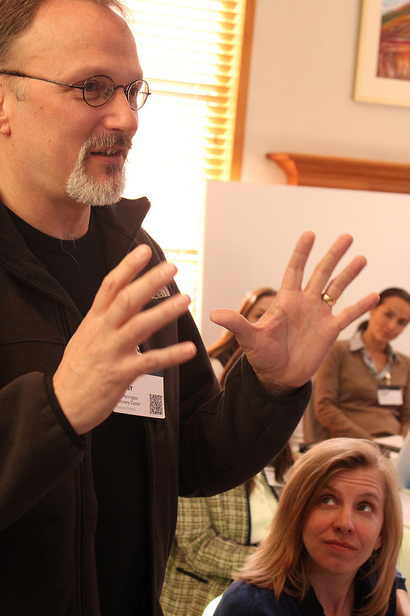 Mr. Spadaccini introduced the Summit with a look at the next 25 years in emerging technology. In that introduction, he identified haptics, speech recognition, augmented reality (AR), gesture recognition, and multitouch as future technology the project would like to bring to the museum floor. (Read more of Jim's insights into emergent technology at the Ideum blog)
Mr. Spadaccini introduced the Summit with a look at the next 25 years in emerging technology. In that introduction, he identified haptics, speech recognition, augmented reality (AR), gesture recognition, and multitouch as future technology the project would like to bring to the museum floor. (Read more of Jim's insights into emergent technology at the Ideum blog)
In closing, Mr. Spadaccini asked "How can we improve the likelihood of this project's success? ...This is not the typical museum crowd - by design... The diversity of talent and ideas in this room is monumental, and I think we have our work cut out for us."
Open Exhibits has secured a 3 year National Science Foundation grant and is less than 6 months into development. The Open Exhibits Design Summit is taking place March 10-11, 2001 in Corrales, NM.
Chip Lindsey at the OE Design Summit
